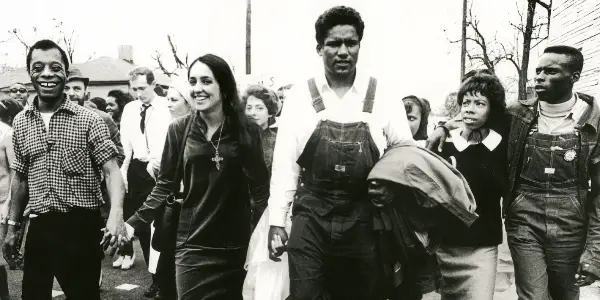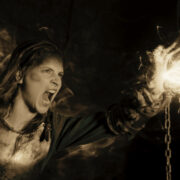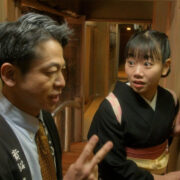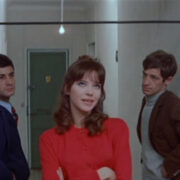JOAN BAEZ I AM A NOISE: Anger Lurking Under A Big Smile

Tynan loves nagging all his friends to watch classic movies…
I’ve always known Joan Baez as one of the great interpreters of song and the owner of one of the most haunting, mellifluous voices of all time. With everything from Paul McCartney‘s “Let It Be” to The Band‘s “The Night They Drove Old Dixie Down” and Bob Dylan‘s entire oeuvre, she’s always made iconic songs her own.
The new documentary about her life reasserts what a prominent talent she was at such a young age buoyed by her vocal talent and fierce social conscience. In Joan Baez I Am A Noise she takes on her whole life and all her relationships with a steely-eyed transparency.
The documentary opens with a telling quote from Gabriel Garcia Marquez, “Everyone has three lives: a public life, a private life, and a secret life.”
The Life of Joan Baez
Over the course of almost two hours, Baez culls through her own personal archives of drawings, photos, home movies, letters, and audio recordings to give the audience the most intimate expression we might possibly ask for. It encapsulates almost every aspect of who she is as a human being across these three dimensions.
In the present, it’s evident her voice is not rusty but reinvented at a lower register, and it’s still absolutely lovely. It’s also a gift to see her early journals as a 13-year-old girl where it’s evident she was coming into her own. Take as an example this one nugget:
“When I think of God, I think of the earth as a very small thing then I think of myself as hardly a speck…might as well spend time making the less fortunate specks in the world enjoy themselves.”
If it’s not apparent already, her upbringing was informed by her Quaker roots — an attunement to the suffering of others — and her half-Mexican heritage made her feel less than in school. Simultaneously she was crippled by anxiety attacks and stayed in therapy since she was 16.
In the music sphere, Baez sharpened her trade and came of age at Club 47. By the age of 18, she was a star thanks to an appearance at the Newport Folk Festival. To the public, she looked peaceful and collected on the outside with all this fame coming her way, while her interior life continued to be full of anxiety.
She felt guilty for her fame at such a young age when so many other people didn’t have that kind of privilege. Simultaneously, there was the dynamic among the three Baez sisters. Eldest sister Pauline became more anonymous and younger sister Mimi tried to compete with Joan though she was more a dancer than a singer ultimately teaming up with Richard Fariña.

Joan readily admits she’s not great with one-on-one relationships. “I’m good with one on two thousand,” she says. All of this also dispels any suggestion that success automatically precludes someone from trauma and struggle. If anything, such a life might only magnify the inner dissonance.
Meeting Dylan and The Addiction of Activism
It takes about 34 minutes into the film to get our first inkling of Bob Dylan as Baez sings a few lines of his early ballad “One Too Many Mornings.”
It’s easy to forget that she was really the first to ascend and she vouched for him as they both rose up as young 20-somethings. Baez acknowledges they changed each other’s lives and the outlook of their respective music careers.
She knew him as Bobby Dylan in NYC as a “tattered little shamble of a human being spouting out these words.” I cannot think of a more apt descriptor and of course, his words would move a generation. They’re still speaking to us.
One of their most memorable associations was during the March on Washington in 1963. Baez was in the thick of it all and she states that she never got over Martin Luther King Jr.’s speech — it’s evident it moves her even to this day. A couple of years later Baez also went down to Montgomery in 1965 to take part in the nonviolent protest with Dr. King.
In contrast to D.A. Pennebaker‘s Dont Look Back, we get Baez‘s reflections on the period happening around the same time in 1965. Being back with Dylan in London was demoralizing for her. He was beginning to evolve, and she didn’t fit easily into the inner circle that formed around him.
She soon founded the Institute for The Study of Nonviolence, chronicled so immaculately by Joan Didion, before connecting with another man who became crucial in her life. David Harris and Baez meeting during the political upheaval of the Vietnam era felt akin to her meeting Dylan in the music world.
And yet she admits she became addicted to activism just as she would become addicted to quaaludes later in life. Saving the world is very intoxicating and especially when Vietnam wound down, it left her at a loss. What’s more, her son was negatively affected by her continual absence. It’s a starkly honest assessment.
In one of her letters, Baez writes, “There’s a powerful lot of anger lurking just under my big smile.” Again it evokes Marquez. There are layers and different facets of her personhood vying for primacy. She was still trying to reconcile with a lot of things in her life.
Conclusion: Joan Baez I Am A Noise
The darkest, heaviest parts of Baez‘s story are not easy to summarize in a few words so I will not attempt to. It’s better to hear it from her own mouth. As she pieces together this process of contending with childhood trauma, we come to realize the whole documentary is a kind of therapy session.
While there’s not as much vocal ease in her later years, the fact that she doesn’t feel like she’s carrying the weight of the world on her shoulders rings with a newfound freedom and optimism (as do the diminishing panic attacks). She continues to age gracefully.
It feels like there’s only one place to end. One of the lines taken from her journals reads, “I am not a saint. I am a noise.” It’s the fitting genesis of the documentary’s title.
In some ways, it sums up what she was able to accomplish during her life on this earth thus far. Like all of us, Joan Baez is not without her flaws and shortcomings, but the noise she made with the song of her life continues to reverberate through time and space and affect people in profound ways. She certainly is a noise and a beautiful one at that.
Does content like this matter to you?
Become a Member and support film journalism. Unlock access to all of Film Inquiry`s great articles. Join a community of like-minded readers who are passionate about cinema - get access to our private members Network, give back to independent filmmakers, and more.
Tynan loves nagging all his friends to watch classic movies with him. Follow his frequent musings at Film Inquiry and on his blog 4 Star Films. Soli Deo Gloria.













